
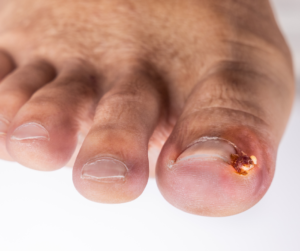 An ingrown toenail develops when a small piece of the nail, or nail spicule, pierces the surrounding skin and begins to grow into the skin, instead of growing out independently alongside the skin. It doesn’t take a big piece of nail to cause you tremendous pain and irritation – think of it like a sharp splinter that gets deeper and gets irritated when you walk or wear closed-in shoes.
The key here is that an ingrown toenail has pierced and entered the skin, as opposed to just rubbing against the skin and causing painful friction. This means that it has created an open wound – even if it’s all the way down the side of the nail. Wherever there is a wound or an opening of the skin, the risk of infection is also always close by – and it may be even closer in this case given the proximity of our feet to the ground and the dirt it carries.
If you’re wondering if the severe pain you’re experiencing from your ingrown toenail is because it’s infected – or if it’s just a deep nail spicule – today we’ve shared some simple signs that may indicate that you have an infection and need more help.
An ingrown toenail develops when a small piece of the nail, or nail spicule, pierces the surrounding skin and begins to grow into the skin, instead of growing out independently alongside the skin. It doesn’t take a big piece of nail to cause you tremendous pain and irritation – think of it like a sharp splinter that gets deeper and gets irritated when you walk or wear closed-in shoes.
The key here is that an ingrown toenail has pierced and entered the skin, as opposed to just rubbing against the skin and causing painful friction. This means that it has created an open wound – even if it’s all the way down the side of the nail. Wherever there is a wound or an opening of the skin, the risk of infection is also always close by – and it may be even closer in this case given the proximity of our feet to the ground and the dirt it carries.
If you’re wondering if the severe pain you’re experiencing from your ingrown toenail is because it’s infected – or if it’s just a deep nail spicule – today we’ve shared some simple signs that may indicate that you have an infection and need more help.
What does an infected ingrown toenail look like?
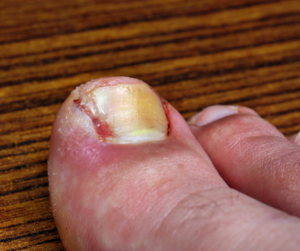 If your ingrown toenail is infected, you may notice:
If your ingrown toenail is infected, you may notice:
- Clear or yellow discharge coming from the side of the nail
- Bleeding from the side of the nail
- Swollen, overgrown or inflamed tissue around the edge of the toenail
- If an abscess develops, you’ll notice a yellow/white fluid-filled pocket
- Redness around the side of the nail
What does an infected ingrown toenail feel like?
- Pain and tenderness around the toenail, especially with the application of any pressure
- Throbbing at the toenail
- Heat or warmth around the nail
- It may feel as if there’s pressure building up beneath the nail
What does an infected ingrown toenail smell like?
Infected ingrown toenails do tend to have a foul or unpleasant smell – which isn’t something that you’d expect from a regular ingrown toenail.
Why infected ingrown toenails are dangerous
Infected ingrown toenails can pose a risk to your health because if your body does not fight off and clear the infection, it can spread or harbour a secondary infection. This may result in the infection spreading to the bone, which is a serious complication and requirements immediate treatment – it may even require surgery.
If you’re unsure – always seek help
It can be difficult to tell an infected ingrown toenail from a non-infected toenail because even without infection, ingrown toenails can swell, and become red and painful. It’s always best to stay safe and put your health first, seeking help at any time that you suspect you may have an infection.
How should you treat an infected ingrown toenail?
Simply put – by seeing your podiatrist! Once an ingrown toenail becomes infected, it requires prompt and effective treatment to both manage the infection and the problem – so that the wound can heal and another infection doesn’t develop.
Here at Perform Podiatry, we treat ingrown toenails in one of three ways:
- Conservative nail care – for first time ingrown toenails, we remove the offending nail spicule if it doesn’t look like the nail will re-grow back and keep causing you pain
- Partial nail avulsion – for recurring ingrown toenails, we remove the nail spicule permanently, using a chemical to prevent the problematic edge of the nail from growing back in the future
- Total nail avulsion – for recurring ingrown toenails that have a secondary problem, like a thickened, damaged or distorted nail – or one with a fungal infection too – we can perform a total nail avulsion. This involves removing the entire nail and allowing it to grow back naturally hopefully without the previous issues.
Worried your ingrown toenail may be infected?
If you need help with a problematic ingrown toenail, our team can help. We’re proud to be one of Auckland’s leading podiatry teams, located within the One Health Building on Remuera Road. Ingrown toenails are one of our specialities.
Book your appointment by calling 09 523 2333 or book online.
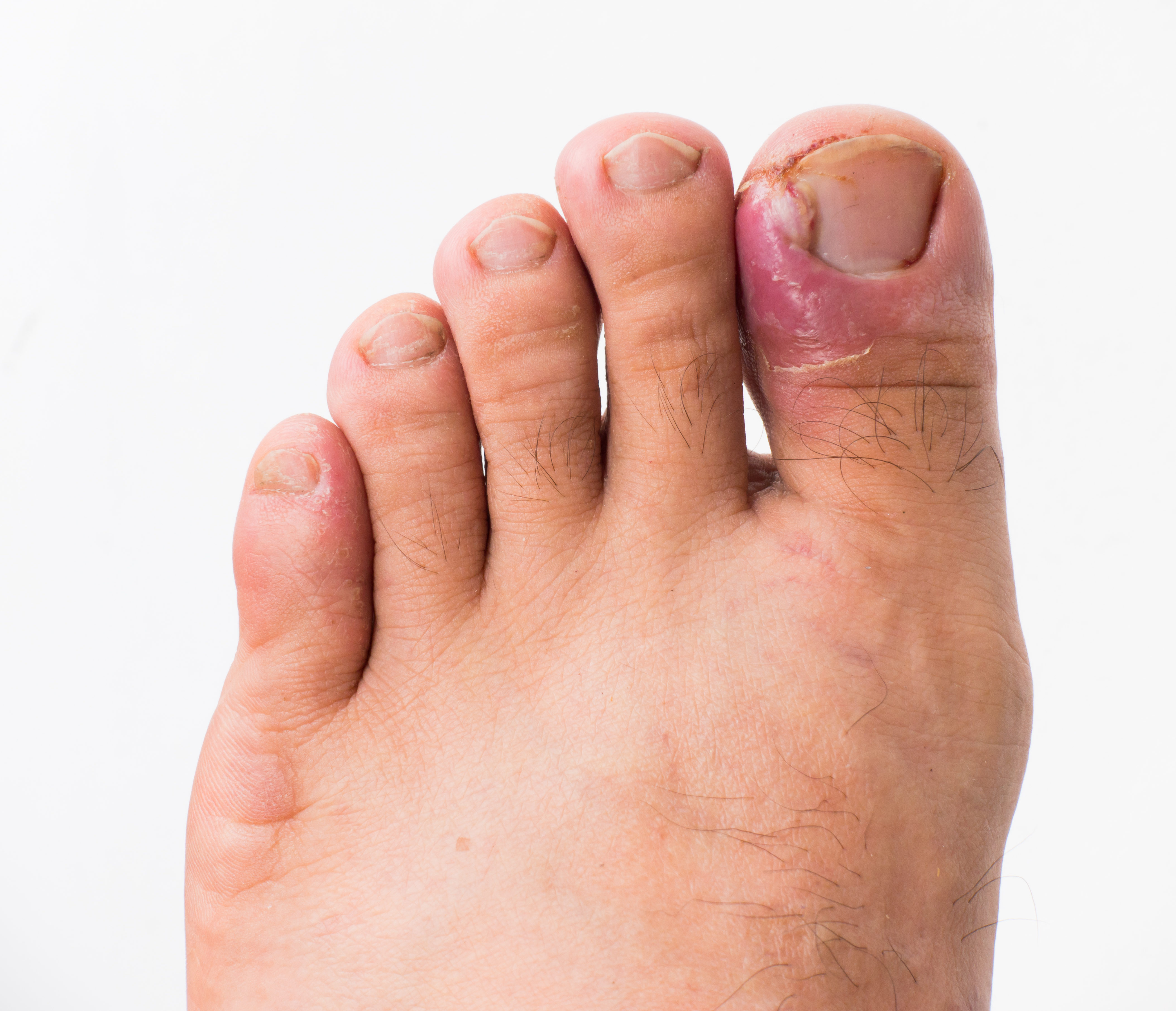
Ingrown toenails are painful and frustrating enough, so the last thing you want is to add an infection to the mix. Unfortunately, in our experience, a large number of ingrown toenails will get infected if proper treatment is undertaken – and it makes sense when you think about it.
Today, our ingrown toenail specialists will be sharing:
- Why the risk of developing an infection once you have an ingrown toenail is high
- What you can do to prevent an infection before it develops
- How you can treat your ingrown toenail and infection once it has occurred
You Have A Significant Risk Of Developing An Infection. Here’s Why
Let’s clear something up: ingrown toenails and infections are not a case of the chicken and the egg – the ingrown toenail comes first.
What classifies a sore toe as an ‘ingrown toenail’ is the moment that the sharp piece of nail goes from merely pushing against the surrounding skin, to actually piercing it and penetrating it.
Think about that for a second – you have a piece of nail that is now constantly inside the skin through a cut down the side of the nail. Every time you walk and move, it’ll move slightly with vibrations of pressures from shoes and socks. Ouch! This also means that while a normal cut occurs and then can heal, this cut can’t – because the ingrown toenail is still constantly piercing it and so keeping the cut open.
An infection occurs when bacteria and other nasties enter the body. Usually, our skin is a fantastic barrier, so while there may be many nasties around us regularly, they never have an ‘in’. Until now. And especially at the ground where you may walk barefooted. And when you give it a perfectly placed entrance – there’s a strong chance that the infection will take hold and start to develop.
Once the infection takes hold, it means increased swelling, pain and oozy discharge (and maybe blood) that is yellow/green/clear in nature and may ‘crust over’.
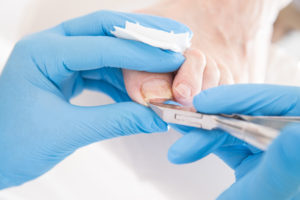
Preventing An Infection From Your Ingrown Toenail Before It Develops
So how, then, can we prevent – or at least reduce the risk – of developing an infection? It’s quite simple, really. And no – no Epsom salts required just yet!
As the cut from ingrown toenail creates an ‘in’ for the bacteria to take hold, the way to prevent an infection is to remove this ‘in’. This means removing the penetrating nail edge so that the cut can heal, close, and no longer be vulnerable to the infection. Simple, right? – Absolutely.
So How Do I Treat My Ingrown Toenail – And The Infection If I Already Have One?
The best way to ensure the proper care of your ingrown toenail is to see your Podiatrist. Our team here at the Ingrown Toenail Clinic are Podiatrists that are trained in simple and painless ingrown toenail surgeries, as well as conservative care where we safely remove that small, pesky nail edge in a matter of minutes. You’ll feel the relief almost instantly!
We don’t recommend trying to cut back the nail at home because often the nail runs much deeper than you can see, so most people will miss removing the complete penetrating edge and their pain will only continue to worsen. You also won’t have the right tools for the job – whereas we have everything needed to do it quickly and easily – even anaesthetic if you need or want it! (though most people don’t).
Once the sliver of nail is removed, the body will be able to effectively heal the wound and fight the infection – and of course, we’ll help it along by dressing it with betadine (antiseptic). You’re welcome to soak it in some Epsom salts too – but once the nail is out, it should be relatively simple and straightforward for it to heal and the infection to subside.
No more painful, swollen discharge – hooray!
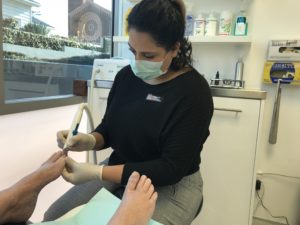
Auckland’s Ingrown Toenail Experts
We’re proud to be Auckland’s only Podiatry clinic that specialises in the safe and effective care of ingrown toenails – and we do a really good job of it. From simple and easy care to quickly remove the small nail edge, to minor nail surgery to permanently correct ingrown toenails, we’ve got you covered.
You can book online here or give us a call on (09) 523 2333.
 An ingrown toenail develops when a small piece of the nail, or nail spicule, pierces the surrounding skin and begins to grow into the skin, instead of growing out independently alongside the skin. It doesn’t take a big piece of nail to cause you tremendous pain and irritation – think of it like a sharp splinter that gets deeper and gets irritated when you walk or wear closed-in shoes.
The key here is that an ingrown toenail has pierced and entered the skin, as opposed to just rubbing against the skin and causing painful friction. This means that it has created an open wound – even if it’s all the way down the side of the nail. Wherever there is a wound or an opening of the skin, the risk of infection is also always close by – and it may be even closer in this case given the proximity of our feet to the ground and the dirt it carries.
If you’re wondering if the severe pain you’re experiencing from your ingrown toenail is because it’s infected – or if it’s just a deep nail spicule – today we’ve shared some simple signs that may indicate that you have an infection and need more help.
An ingrown toenail develops when a small piece of the nail, or nail spicule, pierces the surrounding skin and begins to grow into the skin, instead of growing out independently alongside the skin. It doesn’t take a big piece of nail to cause you tremendous pain and irritation – think of it like a sharp splinter that gets deeper and gets irritated when you walk or wear closed-in shoes.
The key here is that an ingrown toenail has pierced and entered the skin, as opposed to just rubbing against the skin and causing painful friction. This means that it has created an open wound – even if it’s all the way down the side of the nail. Wherever there is a wound or an opening of the skin, the risk of infection is also always close by – and it may be even closer in this case given the proximity of our feet to the ground and the dirt it carries.
If you’re wondering if the severe pain you’re experiencing from your ingrown toenail is because it’s infected – or if it’s just a deep nail spicule – today we’ve shared some simple signs that may indicate that you have an infection and need more help.
 If your ingrown toenail is infected, you may notice:
If your ingrown toenail is infected, you may notice:




